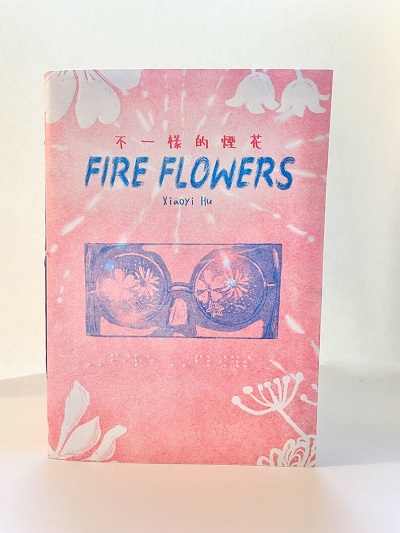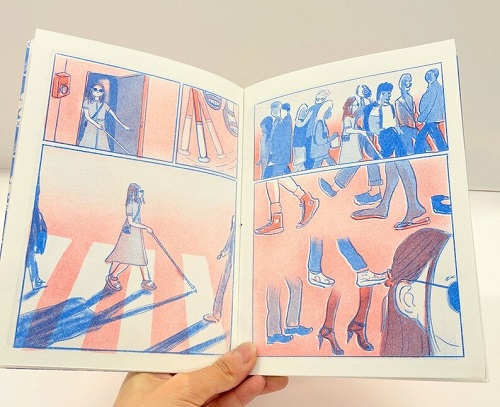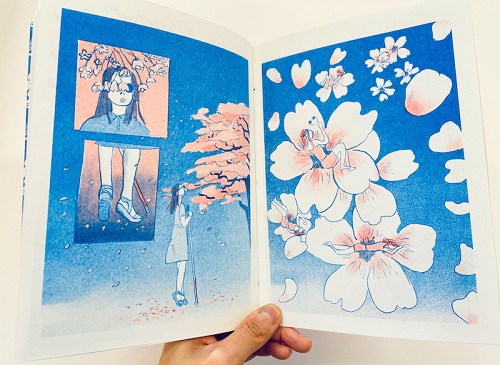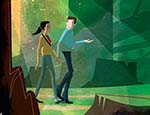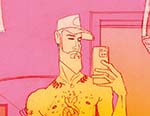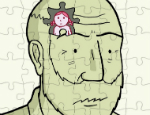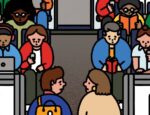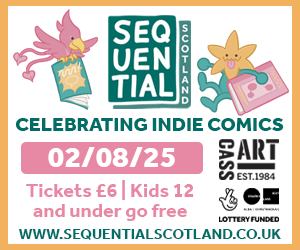10 YEARS OF THE BF SIX TO WATCH! With 2024 bringing our tenth intake of the Broken Frontier ‘Six to Watch’ creators to wider recognition we’re looking forward to celebrating our flagship initiative across 2024 at BF. Today we chat with 2023 ‘Six to Watcher’ Xiaoyi Hu about her practice and her powerful ability to communicate lived experience with an expressive and incisive use of the form. You can read our review of Xioayi’s Fire Flowers, a comic that eloquently portrayed a blind character’s perception of their environment, here at Broken Frontier.

ANDY OLIVER: As one of our 2023 ‘Six to Watch’ creators can you introduce yourself to our readers and tell us a little bit about your artistic practice?
XIAOYI HU: Thank you, Andy, for having me in the Broken Frontier community. I am from south China and graduated with an MA degree in Illustration from Edinburgh College of Art in 2022. In my previous years, I worked as an international cooperation manager in a company. Although since I was a child I’ve always liked drawing, I didn’t have the courage to follow the path in art. It’s not until I was 30 that I started to pick up drawing as a serious hobby. After hobbying for 5 years, I got into ECA and became more engaged with art. I am curious and like experimenting with various mediums in image-making, including printmaking, risograph and ceramics. I found the form of sequential arts and comics most fulfilled my need for storytelling.
AO: Fire Flowers is your breakout comic, reviewed earlier this year at Broken Frontier. What is the premise of the story and the themes it explores?
HU: During the first semester at ECA, I took on an elective research-based course on Multi-Sensory Culture. My research then focused on the multi-sensory experiences of the blind, as I have been always curious about the perception of blind people. Because of this research, I got in contact with two students who are blind, and we thus became friends. Our conversation and interaction were interesting and that brought me much inspiration. I felt they opened a door for me to discover a complete new perspective to sense the world which I, as a sighted person, only used to see it as it is through my eyes.
In one interview, I asked Xi Luo (who lost her sight when she was small) to describe a beautiful scene in her mind. To my surprise, what she depicted were her memories which felt visually vivid with colours, sounds, touch and scents. Inspired by this, this comic depicts a blind character’s multi-sensory interaction with the physical world through a simple daily walk in her neighbourhood. The story tries to convey the message that beauty is not only to be seen by our eyes. Our other human senses can also subtly and deeply trigger a different type of imaginative beauty in our mind.
AO: One of the things I admire the most about your work is how much you clearly understand the language of comics and the storytelling tools that are unique to the form. How did you approach using comics as a medium in Fire Flowers to explore the blind central character’s perceptions of the world?
HU: At the earlier stage of the project, I brainstormed about what I could create in the scope of illustration. I had already a clear message in my mind that I would like to convey in my work as mentioned above. I thought a single illustration series was often lacking of context and that would not be easy for audience to understand the message. I’ve also thought about making an inclusive picture book installation which would combine auditory, tactile and even olfactory elements. However, it was not realistic to put into actual practice and to reproduce it. I did not want to finish the project just for the degree show, but I wanted to create something that would exist and continue to be read in the long run.
With comics, I found it makes everything possible. The story itself contains a bit of ‘another reality’ (imaginative parts from the central character), the flow of sequences in a comic makes a whimsical transition between ‘two worlds’ understandable in the context. And I like the freedom of storyboarding and formatting the page layout in a comic to highlight specific scenes.
At last, in order to make the story accessible to the blind, I’ve also collaborated with my friend Siobhan Lumsden who is a voice actor to turn the comic into an audio book.
AO: The Beginning is a similarly poignant earlier comic from you. Can you give us some background on the real world events that inspired this tale of creativity?
HU: The Beginning was created after one night during lockdown when I happened to watch a short video on YouTube of a homeless man in a square in Edmonton, Canada, who got found by a random pedestrian, playing a very beautiful evocative song composed by himself. He named the song ‘The Beginning’ (where the title for this comic came from). It was a strange deeply emotional moment to me that I kept watching that video over and over again. I couldn’t stop searching for information about the life of this man. His name is Ryan Arcand and he already passed away in 2018. His beautiful song was played by many who still did not know his name.
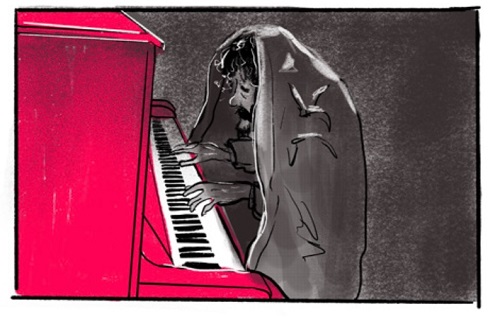
That night I even watched all other videos I could find on internet about homeless people who got found playing street pianos. It came to a point where I couldn’t stop crying, as I felt these were true evidences that showed me how many artists out there in the world led a difficult life, not having a roof over their heads, and yet the purity for art still remains in their heart. I think I could deeply feel their struggle and it amplified my fear in following the path in art then, while recognising their purity at the same time.
AO: A lot of your work in sequential art looks to communicate the intricacies of personal experience, like your zine Be Well. What is it about comics that appeals to you as a storytelling medium?
HU: What appeals to me most about comics is that it allows the full autonomy of my own expression. My ideal state of creating comics was when I could secretly pretend to see myself as a film director and cameraman weaving the visual fragments together for my own literature. Comics carries a story more directly than words. I took it as a more universal language, because sometimes we don’t even need words to understand a comic. In addition, every artist has a visual signature unique to their own as instantly seen in their styles, which makes comics more interesting, open and diverse in personalities. I felt it somehow brought me more self-fulfillment and meaning in completing a comic zine than a series of illustrations.
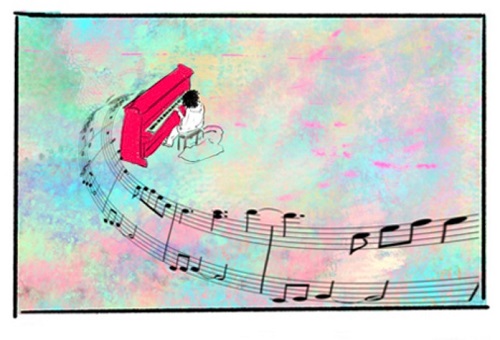
AO: Your art has a beautifully haunting feel to it. What mediums do you work in to create your comics?
HU: Thank you very much. For comics, I used mostly Procreate in iPad Pro, sometimes markers and ink in limited colours, and then print it with riso if it’s accessible. I’ve also been experimenting in other traditional mediums for comics this past year, such as watercolour.
AO: What are the special qualities that you feel riso printing brings to your work?
HU: I really like the surprising effect of printmaking. Riso printing as a type of digital screen printing has also brought some surprises to me. It has such stunning bright colors that it makes my works looks catchier in physical than from the screen. And the lovely grainy texture and occasional ‘mis-registered’ prints gives an authentic handmade touch to my books.
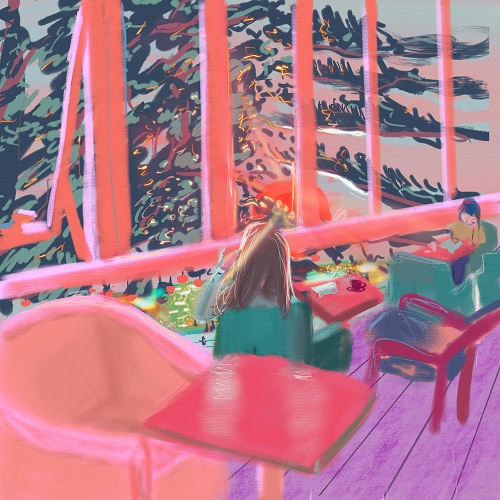
AO: What are you currently working on either in comics or in other areas of the arts? And what can we expect from Xiaoyi Hu in 2024?
HU: I’m currently working on a new comic inspired by my encounters with dead butterflies. I’m also drafting some other projects, but I think it might be better to reveal it when I actually complete them. Beside these I’m launching a small-batch ceramics on my Etsy shop.
Buy Xiaoyi Hu’s print work here
Follow Xiaoyi on Instagram here
Interview by Andy Oliver
2024 marks the tenth year of Broken Frontier’s ‘Six to Watch‘ initiative. Look for articles throughout the year celebrating the work of those artists who have been a part of the programme.





